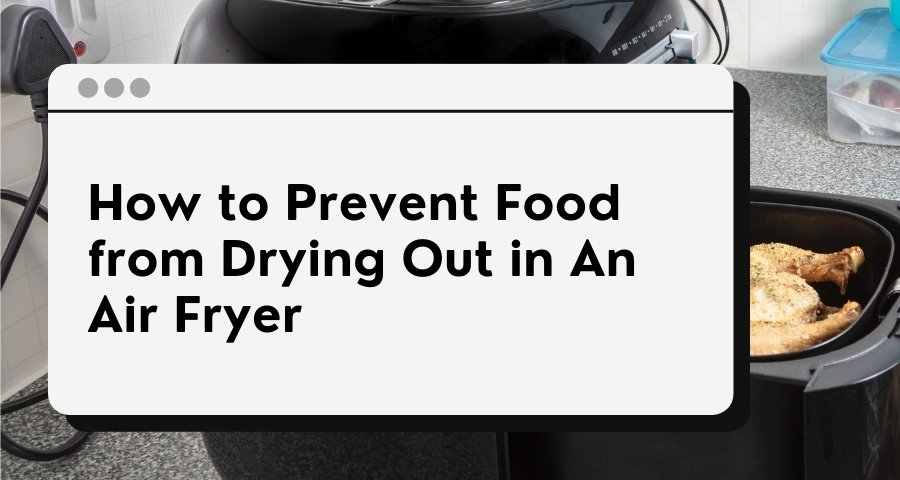Air fryers have revolutionised home cooking, offering a healthier alternative to deep-frying while maintaining the crispiness and flavour of food. With many options available in the market, you are spoilt for choice when shopping for an air fryer in Singapore. However, many users struggle with a common air frying issue—food drying out instead of staying juicy and tender. This happens when moisture is lost due to high temperatures, prolonged cooking times, or inadequate preparation.
Fortunately, with the right techniques, you can keep your food succulent and delicious while still enjoying the air-fried texture. This guide explores practical methods to prevent food from drying out in an air fryer, ensuring every meal remains flavourful and satisfying.
Why Does Food Dry Out in an Air Fryer?
Understanding why food becomes dry in an air fryer is the first step to solving the problem. Unlike deep frying, which submerges food in oil, air fryers use rapid hot air circulation to cook ingredients. While this results in crispiness, it can also remove moisture too quickly if precautions are not taken.
Here are the main reasons food dries out in an air fryer:
- Overcooking – Cooking food for too long at high temperatures depletes moisture.
- Lack of oil – Although air fryers require less oil than deep-frying, a light coating helps retain moisture.
- Inadequate marination – Dry cuts of meat benefit from marinades or brining.
- Improper placement – Overcrowding the basket leads to uneven cooking, while small portions may dry out faster.
By recognising these factors, you can adjust your air-frying technique to retain moisture and enhance texture.
Tip #1: Adjusting Cooking Temperatures and Times
One of the most effective ways to prevent food from drying out is by controlling temperature and time settings.
Recommended Cooking Temperatures
Air fryers typically cook faster than conventional ovens, so lowering the temperature prevents excessive moisture loss.
- Meat & Poultry: 170°C–190°C
- Fish & Seafood: 160°C–180°C
- Vegetables: 150°C–180°C
- Baked Goods: 140°C–160°C
Lowering the temperature by 10–20°C from standard oven recommendations helps retain juiciness without compromising texture.
Timing Adjustments
Shorter cooking durations with regular flipping or shaking prevent food from drying out. If a recipe recommends 20 minutes in an oven, start with 15 minutes in an air fryer and check for doneness.
Tip #2: Using Marinades and Brines for Moisture Retention
For meats and seafood, marinating before air frying enhances flavour and retains moisture.
Marination Tips
- Use oil-based marinades with herbs, citrus, and garlic.
- Let the food soak for at least 30 minutes before air frying.
- Avoid excess moisture—pat food dry before cooking to prevent steaming.
Brining for Extra Tenderness
Brining is particularly effective for chicken breasts, pork chops, and lean cuts that tend to dry out quickly.
Simple Brine Recipe:
- 1 litre water
- 2 tbsp salt
- 1 tbsp sugar (optional)
- Herbs and spices for flavour
Soak meat for 30 minutes to 2 hours, then air fry for juicier results.
Tip #3: Using the Right Cooking Oils
While air fryers use less oil than traditional frying, a light coating of oil locks in moisture and enhances crispiness.
Best Oils for Air Frying
- Olive oil – Ideal for meats and vegetables
- Avocado oil – High smoke point, perfect for high-heat cooking
- Coconut oil – Adds a mild sweetness to baked goods
Avoid excess oil, as too much can cause smoking or soggy textures. A light spray or brush is sufficient.
Tip #4: Arranging Food for Even Cooking
How you place food in the air fryer basket impacts texture and moisture retention.
Key Tips for Proper Arrangement
- Avoid overcrowding – Leave gaps between pieces for airflow.
- Use perforated parchment paper – Prevents sticking while allowing airflow.
- Elevate with a rack – Allows better circulation for meats.
Overcrowding leads to uneven cooking—some parts may overcook while others remain undercooked.
Tip #5: Wrapping or Covering for Extra Protection
If you’re air-frying delicate foods such as fish, baked goods, or cheese-stuffed dishes, covering them prevents direct exposure to hot air.
- Aluminium foil – Helps lock in moisture but should not completely enclose food.
- Parchment paper – Allows airflow while preventing sticking.
- Silicone liners – Reusable and prevent excessive browning.
These methods work well when reheating leftovers, as they prevent further moisture loss.
Tip #6: Using Water or Broth to Add Humidity
Placing a small heatproof dish with water or broth inside the air fryer creates steam, reducing dryness.
Ideal for:
- Reheating rice or bread – Prevents them from turning hard.
- Cooking dense meats – Retains tenderness.
Adding moisture inside the fryer helps mimic oven steaming, keeping food juicy.
Tip #7: Resting Food After Cooking
Just like with traditional cooking, letting food rest before serving allows juices to redistribute.
- Steaks and poultry: Rest for 5 to 10 minutes before cutting.
- Baked goods: Cool slightly to maintain moisture.
Resting time enhances flavour and prevents dryness.
Final Thoughts
Air fryers offer a healthier way to prepare meals, but avoiding dryness requires proper techniques. By adjusting temperatures, using marinades, coating food with oil, and arranging items correctly, you can enjoy perfectly air-fried dishes every time. With these simple tweaks, your air fryer meals will turn out juicy, delicious, and full of flavour every time.

